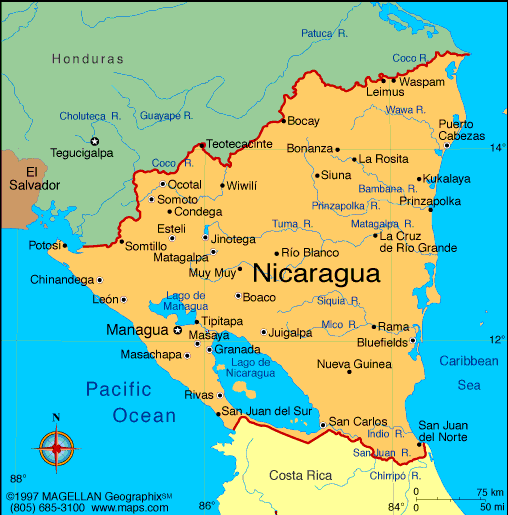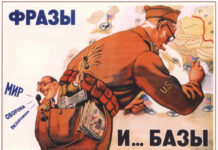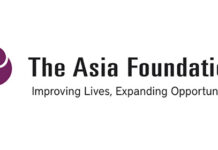
For over seven weeks, events in Nicaragua have devolved into an increasingly common scenario for leaders who find themselves at odds with Washington: the country’s president, Daniel Ortega, stands accused of “killing his own people” after authorities have used “lethal force” in quelling recent protests. The unrest, which has resulted in the deaths of more than 110 people, has brought increasing pressure on Ortega’s government, as the United Nations, establishment human rights groups such as Amnesty International, and the U.S.-dominated Organization of American States (OAS) have come out in support of the political opposition amid Ortega’s “repression” of domestic dissent.
As with similar events that have rocked countries like Venezuela, Syria and others in recent years, corporate media outlets have overwhelmingly condemned the “thuggish” response of the Nicaraguan government to the protests — painting Ortega as a despot who has unfairly “dominated” politics for decades, even though he won the country’s last election in 2016 with three-fourths of the vote.
The narrative is uncannily similar to that often told regarding current events in Venezuela, as Ortega remains Venezuela’s staunchest ally in Latin America and one of the few Latin American left-of-center governments to withstand the tide of recent coups that have befallen similar governments in the region over the last decade.
The similarities between current events in Venezuela and Nicaragua don’t stop there. Indeed, much like the unrest in Venezuela, the recent unrest in Nicaragua bears all the signs of U.S. involvement – an indication that the American Empire seeks to continue to consolidate its influence over Latin America by any means necessary.
From burning forests to burning buildings: incendiary violence spreads in Nicaragua
In mid-April, forest fires in the Indio Maiz Biological Reserve quickly became uncontrollable and greatly damaged one of Nicaragua’s most protected and ecologically important forests, as thousands of hectares were destroyed. University students in the capital of Managua began protesting soon after – blaming the government for failing to prevent the blaze.
Upon closer examination of the events, the student’s outrage seemed misplaced for several reasons. First, the cause of the fires was widely suspected to be arson caused by shady, private operatives, as the reserve has been targeted by powerful agricultural interests that have sought to claim parts of the area in attempts to expand. Furthermore, the government of Nicaragua has worked to protect the reserve for years — as the country’s military, police force and other government agencies have been present in the reserve — though its limited resources have been strained, given the size of the area under protection.
While the government could be blamed for not putting enough resources into preventing arson, it went into action as soon as the fire broke out, devoting nearly 1,500 servicemen, nine aircraft, and 17 naval ships to combat the blaze. They succeeded in reducing – but not eliminating – the fire, partly because yolillal trees present in the reserve contain large amounts of a particular oily resin that helps to fan the flames.
Despite these factors, the students in Managua chose exclusively to target the government for the blaze, failing to rally against the powerful, private ranching interests likely responsible for starting the fire in the first place. Since then, student protests have continued, growing stronger as the Ortega-led government sought to reform a pension program quickly approaching insolvency, resulting in an immediate backlash among the already-protesting student groups when the announcement was made that benefits would be reduced.
The unrest has since continued unabated — devolving into protester “gangs” battling each other, as opposition groups have taken to erecting “makeshift barricades to damage the economy and wear down the government,” already costing the Nicaraguan economy an estimated $250 million.
As with other examples of civil unrest in Latin America — first and foremost being Venezuela — most media reports have portrayed the opposition groups and protesters as a “ragtag” team of students, farmers and academics who have decided to rise up against an oppressive leader. However, examples of opposition violence, such as opposition use of “homemade mortars” and “gas bombs” as well as the burning of public buildings, have received minimal coverage in Western media.
While political discontent with Ortega has been a factor in Nicaraguan politics since he assumed the presidency in 2007, such narratives overlook the glaring influence of foreign governments, especially the United States, over many of the most influential groups that have called for Ortega’s resignation and sought to bring the country’s economy to a standstill.
Like the Contras, only softer
The U.S. has long sought Ortega’s downfall, given that he and the Sandinista movement he once led were responsible for the undoing of the U.S.-backed Somoza political dynasty and the fact that Ortega successfully resisted years of a U.S.-funded Contra insurgency. However, this time around, the U.S. has sought to use more covert means – as it has recently done in other countries – to grease the skids for Ortega’s ouster.
The Civic Youth Movement (Movimiento Cívico de Juventudes, MCJ), one of the main “student” groups behind the recent protests in Nicaragua, was created by and received funding from the National Democratic Institute (NDI) and MCJ’s general secretary, Davis José Nicaragua López, is the coordinator of NDI for Nicaragua. The current president of NDI is the former secretary of state under Bill Clinton, Madeleine Albright.
Albright is best known for stating that the deaths of some 500,000 Iraqi children due to U.S.-imposed sanctions was “worth it.” She has since been an advocate for current U.S.-backed regime-change efforts elsewhere and serves as Director Emerita of the Council on Foreign Relations.
In addition, U.S. government organizations that have frequently come under fire for “meddling” in the politics of other nations have been funneling money to Nicaraguan opposition groups for years. For instance, the National Endowment for Democracies (NED), which gave over $2 million to the anti-Sandinista opposition in Nicaragua in the 1980s, is at it again – funding a variety of “democracy promoting” projects in Nicaragua, giving some $4.2 million to opposition groups and affiliates from 2014 to 2017. Analysts have long noted that the NED operates as the “legal part of illegal CIA operations” aimed at destabilizing politicians and institutions that work against U.S. interests.
Another “instrument of regime change” commonly used by the U.S. is the U.S. Agency for International Development (USAID), which has a very active presence in Nicaragua that has focused on “training young, emerging democratic leaders.” In addition, USAID has received the bulk of U.S. assistance given to Nicaragua in recent years, receiving $52 million for its Nicaragua-based operations between fiscal year 2016 and 2018, accounting for more than 80 percent of all U.S. aid given to the country over that time frame.
Hitting Nicaragua with the “Venezuela Model”
The violence in Nicaragua is remarkably similar to that in Venezuela, where the U.S. also funds opposition groups and “promotes democracy:” In both countries masked opposition protesters have taken to using various homemade weapons and explosives, putting up barricades to block transportation, and engaging in gun fights with police. Yet they have been treated in media reports as “student-led protests” that have been subjected to a “brutal crackdown.” Given the circumstances, however, it is hard to imagine a police force in any country that would allow “protesters” wielding hand-held mortar cannons and machine guns to act as they wished without responding.
Another similarity is that the same institutions have come out in support of opposition groups and condemned government “crackdowns” in both countries, including groups like Amnesty International and Human Rights Watch. Both of those human rights groups have, in recent years, come out in support of Western-backed regime change conflicts, particularly Syria as well as Venezuela, among others.
Chief among these institutions has been the Washington-based Organization of American States, which – as MintPress recently reported – has long been regarded as a tool of U.S. imperialism that has most recently been weaponized for regime change in the Americas. Venezuela has been the focus of those efforts as of late, with U.S.-backed efforts to expel Venezuela from the group and OAS officials such as its Secretary General Luis Almagro voicing great enthusiasm for regime change in Caracas.
While the OAS has yet to come out in force against Nicaragua, if the government continues to act against the armed protesters – as is likely – the organization’s criticism of Ortega will likely grow and lead to his isolation, as was the case with Venezuela. “We condemn the killings carried out by the repressive forces and the armed forces and we express our solidarity with the families of the victims,” Almagro stated last Saturday, adding that the OAS called “on the state to stop the violence by these repressive factors.”
Media coverage in the West has essentially the same narrative for Nicaragua as it has previously used for Venezuela. According to that narrative, Ortega, like Maduro, is a despot so intent on clinging to power that he is willing to “kill his own people” in a desperate attempt to silence the opposition. Pro-government “mobs” are to blame for the bulk of the violence while the police account for the rest. The opposition’s use of “homemade mortars,” “gas bombs,” other explosives, and snipers is conveniently omitted from such reports. Also absent from reporting have been the ties of the opposition groups to the U.S. government.
A recent Reuters article cited a handful of individuals and groups as evidence that Ortega’s “pillars of support” were eroding. Among those cited were Carlos Tunnermann Bernheim – a former Ortega ally who became a government critic after gaining a prominent position at OAS and the Inter-American Commission on Human Rights, which Reuters failed to note is an extension of OAS. Reuters also cited the Superior Council of Private Enterprise in Nicaragua (COSEP) as proof that the country’s entire private sector had abandoned Ortega. However, the report failed to mention that COSEP regularly collaborates with the U.S. government.
The parallels between current unrest in Nicaragua and similar violence in Venezuela are so obvious that both the Venezuelan government and opposition have commented on the similarities in recent days.
Venezuela’s right-wing opposition coalition, the Democratic Unity Roundtable (MUD), has voiced its support for the protesters, asserting that the Nicaraguan government was using a model of state repression of dissidents that was “exported” from Venezuela. “We call on the international community to support the struggle of the Nicaraguan people as they have done with Venezuela,” the MUD said in a statement.
The MUD, like the several groups now seeking to depose Ortega in Nicaragua, has greatly benefited from the millions of dollars funneled to opposition groups and “democracy promotion” by the U.S. government since 2002.
On the other side of Venezuela politics, Venezuelan President Nicolas Maduro, an ally of Ortega, has condemned the violence of opposition groups in Nicaragua, comparing them to the deadly anti-government mobilizations led by the MUD last year that left more than 125 dead over four months.
“Just as they hurt Venezuelans,” Maduro recently stated, “so they are hurting Nicaraguans [with] violence, fire, bullets and death.”
A chain of hard and soft regime-change coups
Given the proven involvement of the U.S. in the current protests and the similarities in tactics between U.S.-backed Nicaraguan and Venezuelan opposition groups, it is surprising that more attention has not been paid to Ortega’s own concerns regarding the foreign influence on the recent violence.
Indeed, Ortega has directly blamed the United States for the violence, accusing the Trump administration of sponsoring the protests against his government as part of a wider effort to weaken the progressive governments in Latin America that came to power as part of the so-called marea rosada, or pink tide.
The omission of Ortega’s accusation of the U.S. role in the unrest from media reports is very telling, given that there is considerable evidence to support his claims of U.S.-backed efforts that have lead to the removal of most of the region’s progressive governments over the last decade.
First, in 2009, the U.S. backed a military coup in Honduras that saw the country’s leftist president, Manuel Zelaya, removed from power and replaced with a U.S.-friendly, neoliberal, and authoritarian government, which has manipulated elections to stay in power and overseen a surge in activist murders since coming to power.
Next, in 2012, a “soft coup” in Paraguay pushed left-center Fernando Lugo from the presidency and replaced him with his long-time political enemy, Frederico Franco. Subsequent elections put Franco’s associate, Horacio Cartes, into power, where he realigned the country with U.S. interests.
After the success of the “soft coup” in Paraguay, the same tactic was repeated in 2016 in Brazil, leading to the removal of leftist Dilma Rousseff from office and her replacement with the unelected and deeply unpopular Michel Temer. Co-conspirators of the Brazilian “soft coup” have since succeeded in imprisoning the leading presidential frontrunner and Rousseff ally, Luiz Inacio Lula da Silva, prior the country’s upcoming election.
Most recently, Ecuadorian President Lenin Moreno — elected last year — has sought to undermine the work of his predecessor and former ally, Rafael Correa, first by barring Correa from seeking re-election and removing Correa loyalists from his cabinet. Moreno has since sought to court the U.S. by gagging journalist Julian Assange, now an Ecuadorian citizen, and beginning the process of allowing the U.S. military to reestablish its presence in the country after Correa closed the U.S. military base there in 2009.
U.S. efforts to oust Ortega, as he himself has pointed out, are just the latest example of this trend of toppling progressive governments throughout the region with the aim of securing U.S. dominance over its southern neighbors and their resources for years to come. More importantly, however, it illustrates the U.S.’ increasing reliance on covert means of effecting regime change, manipulating opposition groups and media narratives to mask its role behind deadly unrest throughout Central and South America.

CovertAction Magazine is made possible by subscriptions, orders and donations from readers like you.
Blow the Whistle on U.S. Imperialism
Click the whistle and donate
When you donate to CovertAction Magazine, you are supporting investigative journalism. Your contributions go directly to supporting the development, production, editing, and dissemination of the Magazine.
CovertAction Magazine does not receive corporate or government sponsorship. Yet, we hold a steadfast commitment to providing compensation for writers, editorial and technical support. Your support helps facilitate this compensation as well as increase the caliber of this work.
Please make a donation by clicking on the donate logo above and enter the amount and your credit or debit card information.
CovertAction Institute, Inc. (CAI) is a 501(c)(3) non-profit organization and your gift is tax-deductible for federal income purposes. CAI’s tax-exempt ID number is 87-2461683.
We sincerely thank you for your support.
Disclaimer: The contents of this article are the sole responsibility of the author(s). CovertAction Institute, Inc. (CAI), including its Board of Directors (BD), Editorial Board (EB), Advisory Board (AB), staff, volunteers and its projects (including CovertAction Magazine) are not responsible for any inaccurate or incorrect statement in this article. This article also does not necessarily represent the views the BD, the EB, the AB, staff, volunteers, or any members of its projects.
Differing viewpoints: CAM publishes articles with differing viewpoints in an effort to nurture vibrant debate and thoughtful critical analysis. Feel free to comment on the articles in the comment section and/or send your letters to the Editors, which we will publish in the Letters column.
Copyrighted Material: This web site may contain copyrighted material the use of which has not always been specifically authorized by the copyright owner. As a not-for-profit charitable organization incorporated in the State of New York, we are making such material available in an effort to advance the understanding of humanity’s problems and hopefully to help find solutions for those problems. We believe this constitutes a ‘fair use’ of any such copyrighted material as provided for in section 107 of the US Copyright Law. You can read more about ‘fair use’ and US Copyright Law at the Legal Information Institute of Cornell Law School.
Republishing: CovertAction Magazine (CAM) grants permission to cross-post CAM articles on not-for-profit community internet sites as long as the source is acknowledged together with a hyperlink to the original CovertAction Magazine article. Also, kindly let us know at info@CovertActionMagazine.com. For publication of CAM articles in print or other forms including commercial internet sites, contact: info@CovertActionMagazine.com.
By using this site, you agree to these terms above.
About the Author

Whitney is a staff writer for MintPress News and a contributor to Ben Swann’s Truth in Media.
Webb’s work has appeared in numerous publications including Global Research and 21st Century Wire. She has also made radio and TV appearances on RT and Sputnik.











Incisive reporting showing how US imperialism applies military, political, and economic pressure on governments seeking autonomy and respect, contributing to higher levels of poverty, destabilization and armed confrontation. The CIA modus operandi is to use the NGOs and other front groups to organize protests against governments it seeks to overthrow in the name of democracy. Unfortunately, the Nicaraguan government is making this process a bit easier than in other circumstances.